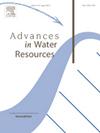Scale-dependent permeability in geologic formations: Renormalization group theory and finite-size scaling analysis
IF 4.2
2区 环境科学与生态学
Q1 WATER RESOURCES
引用次数: 0
Abstract
Understanding the scale dependence of permeability () of geologic formations at field scales is essential for precise modeling of flow and transport in subsurface, particularly for underground energy storage. In this study, we conducted extensive computations and investigated the scale dependence of in random and heterogeneous formations by employing renormalization group theory (RGT) and finite-size scaling analysis. Based on the random permeability field and following the Gaussian distribution of , we first generated ten formations with different levels of heterogeneity at five dyadic domain sizes, = 2i, . The first formation reflects the permeability distribution of an actual reservoir, while the others were generated with varying degrees of heterogeneity. We then applied the RGT to determine the effective permeability () of each formation at various occupation probabilities = 0.5, 0.6, 0.7, 0.8, 0.9 and 1. We next used finite-size scaling theory to further analyze the scale-dependent . The plot for each formation was scattered. However, by applying the finite-size scaling analysis the data collapsed onto a single quasi-universal curve. It means that finite-size scaling theory could successfully incorporate the effect of large-scale heterogeneities in the scale dependence of permeability.
地质地层中依赖尺度的渗透率:重整化群论和有限尺度尺度分析
了解地质地层渗透率(k)在野外尺度上的尺度依赖性,对于精确模拟地下流体和输送,特别是地下能量储存至关重要。在这项研究中,我们进行了大量的计算,并利用重整化群论(RGT)和有限尺寸尺度分析研究了k在随机和非均质地层中的尺度依赖性。基于随机渗透率场,遵循ln(k)的高斯分布,我们首先在5个二元域尺寸上生成了10个不同非均质程度的地层,L = 2i, i∈{3,…,7}。第一个地层反映了实际储层的渗透率分布,而其他地层具有不同程度的非均质性。然后,我们应用RGT来确定不同占领概率p = 0.5、0.6、0.7、0.8、0.9和1时每个地层的有效渗透率(keff)。接下来,我们使用有限尺度理论进一步分析了尺度相关的keff。每个地层的keff−L图是分散的。然而,通过应用有限尺寸的缩放分析,数据崩溃到一个单一的准通用曲线。这意味着有限尺度尺度理论可以成功地将大尺度非均质性的影响纳入渗透率的尺度依赖性中。
本文章由计算机程序翻译,如有差异,请以英文原文为准。
求助全文
约1分钟内获得全文
求助全文
来源期刊

Advances in Water Resources
环境科学-水资源
CiteScore
9.40
自引率
6.40%
发文量
171
审稿时长
36 days
期刊介绍:
Advances in Water Resources provides a forum for the presentation of fundamental scientific advances in the understanding of water resources systems. The scope of Advances in Water Resources includes any combination of theoretical, computational, and experimental approaches used to advance fundamental understanding of surface or subsurface water resources systems or the interaction of these systems with the atmosphere, geosphere, biosphere, and human societies. Manuscripts involving case studies that do not attempt to reach broader conclusions, research on engineering design, applied hydraulics, or water quality and treatment, as well as applications of existing knowledge that do not advance fundamental understanding of hydrological processes, are not appropriate for Advances in Water Resources.
Examples of appropriate topical areas that will be considered include the following:
• Surface and subsurface hydrology
• Hydrometeorology
• Environmental fluid dynamics
• Ecohydrology and ecohydrodynamics
• Multiphase transport phenomena in porous media
• Fluid flow and species transport and reaction processes
 求助内容:
求助内容: 应助结果提醒方式:
应助结果提醒方式:


